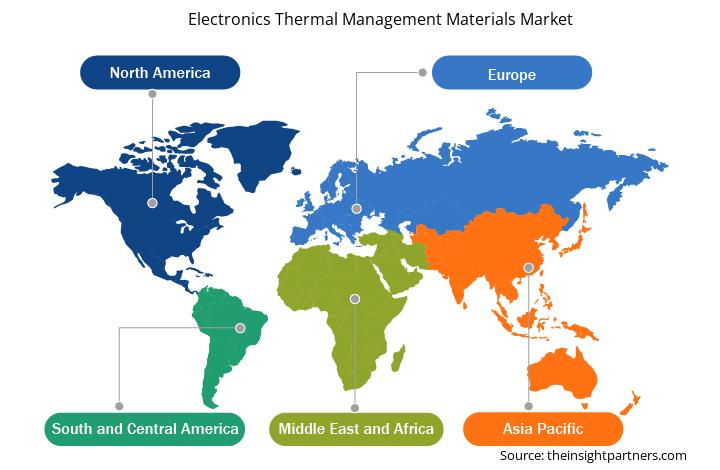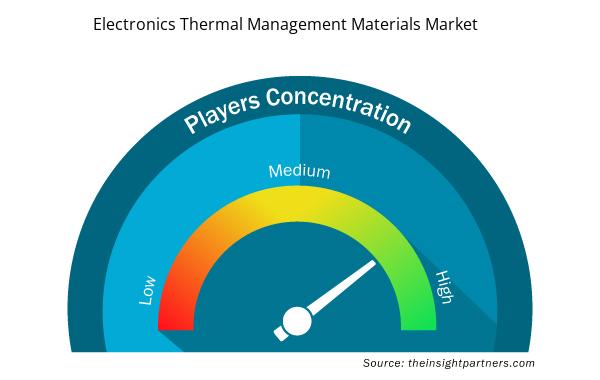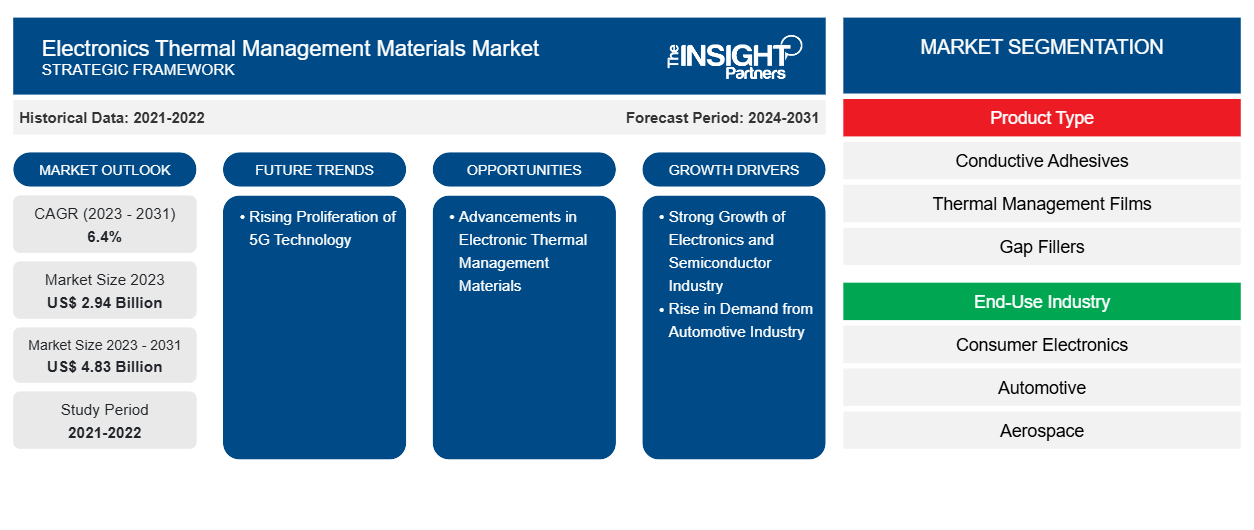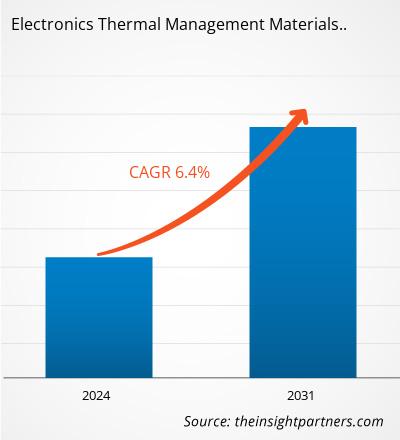电子热管理材料市场规模预计将从 2023 年的 29.4 亿美元增至 2031 年的 48.3 亿美元。预计 2023-2031 年期间该市场的复合年增长率将达到 6.4%。由于电子和半导体行业的强劲增长,电子热管理材料在全球范围内受到青睐。
电子热管理材料市场分析
随着电子设备变得越来越强大、紧凑和热敏感,电子热管理材料市场获得 了显著的发展。热管理材料,包括导电粘合剂、导热凝胶、导热油脂、相变材料和散热器,在散热和确保电子元件的可靠性和效率方面发挥着至关重要的作用。市场增长是由消费电子、汽车、电信和数据中心等行业日益增长的需求推动的。特别是,电动汽车 (EV) 和 5G 基础设施的兴起加剧了对先进热管理解决方案的需求,以防止过热并延长设备寿命。关键挑战包括需要具有高导热性、机械稳定性和与微型电子产品兼容性的材料。纳米技术和材料科学的技术进步正在推动创新产品的开发,例如基于石墨烯的 TIM 和先进的相变材料,从而提高性能和能源效率。
电子热管理材料市场概览
电子热管理材料市场正在经历强劲增长,这得益于消费电子、汽车和电信等行业日益增长的需求。随着电子设备变得越来越强大、紧凑和复杂,管理组件产生的热量对于确保性能、可靠性和使用寿命至关重要。热管理材料旨在有效散热,从而防止过热并提高设备性能。在消费电子领域,智能手机、平板电脑和游戏机等设备的日益普及推动了对有效热管理解决方案的需求。汽车行业是另一个重要驱动因素,尤其是随着电动汽车 (EV) 和自动驾驶技术的发展,这些技术涉及需要高效冷却解决方案的高功率电子设备。此外,电信行业,尤其是随着 5G 基础设施的扩展,严重依赖先进的热管理材料来处理高性能网络设备。
定制此报告以满足您的需求
您可以免费定制任何报告,包括本报告的部分内容、国家级分析、Excel 数据包,以及为初创企业和大学提供优惠和折扣
- 获取此报告的关键市场趋势。这个免费样品将包括数据分析,从市场趋势到估计和预测。
电子热管理材料市场驱动因素和机遇
电子及半导体行业强劲增长
电子和半导体行业的快速扩张是电子热管理材料需求的主要驱动力。随着电子设备变得越来越强大和紧凑,它们产生的热量也越来越高,因此需要先进的热管理解决方案来保持运行效率并延长设备使用寿命。这些材料对于管理智能手机、笔记本电脑和汽车电子设备等设备中的处理器、内存模块和电力电子设备等组件的热量至关重要。在小型化和性能增强至关重要的半导体领域,有效的散热对于防止过热和确保稳定运行至关重要,从而推动了对创新热管理材料的需求。根据 Invest India 的数据,全球电子制造服务市场预计到 2026 年将达到 11,450 亿美元,2021-2026 年的复合年增长率为 5.4%。印度品牌资产基金会表示,预计到 2025 年,印度电子制造业的规模将达到 5200 亿美元。此外,物联网 (IoT) 近年来在全球广受欢迎,企业也意识到了连接的重要性。物联网让每台设备都能连接到互联网。根据国际数据公司 (IDC) 的数据,到 2025 年,416 亿台物联网设备将能够生成 79.4 泽字节 (ZB) 的数据。
电子热管理材料的进展
电子热管理材料的进步有望通过解决现代电子产品中日益增加的热挑战来创造巨大的增长机会。随着设备变得越来越强大和紧凑,具有增强导热性、灵活性和耐用性的新材料对于有效管理更高的热负荷至关重要。例如,石墨烯和碳基材料的创新提供了超高导热性和轻量化解决方案,使其成为高性能电子产品和电动汽车应用的理想选择。这些进步使制造商能够设计出更高效、更紧凑的散热解决方案,从而提高设备性能和使用寿命。相变材料和纳米技术的发展也促进了该市场的增长。2024 年 10 月,德克萨斯大学奥斯汀分校开发了一种新型热界面材料,可以节省 13% 的冷却需求或 5% 的整体数据中心能源使用量,如果在整个行业应用,将节省大量成本。据研究人员称,冷却占数据中心能源使用量的约 40%,即每年 8 太瓦时。这种材料可以从 16 平方厘米的小面积中去除 2,760 瓦的热量。它可以将整个电子冷却结构的重要组成部分冷却泵所需的能量减少 65%。
电子热管理材料市场报告细分分析
有助于得出电子热管理材料市场分析的关键部分是产品类型和最终用途行业。
- 根据产品类型,电子热管理材料市场细分为导电粘合剂、热管理膜、间隙填充物、导热凝胶、相变材料、导热油脂等。导热油脂部分在 2023 年占据了最大的市场份额。
就终端使用行业而言,市场细分为消费电子、汽车、航空航天、电信等。2023 年,汽车行业占据了市场主导地位。
电子热管理材料市场份额(按地区)分析
电子热管理材料市场报告的地理范围主要分为五个区域:北美、亚太、欧洲、中东和非洲、南美和中美。
2023 年,亚太地区主导了电子热管理材料市场。由于汽车、电子和半导体行业的不断发展,亚太地区是利用电子热管理材料的主要市场之一。该地区拥有世界上一些最大的半导体和电子产品生产商,韩国、中国和台湾等国家在全球市场处于领先地位。中国、印度和韩国等国家车队车辆数量的增加推动了对印刷电路板 (PCB) 和半导体的需求,进一步增强了对电子热管理材料的需求。随着中国发展成为高技能制造业中心,韩国、印度、台湾和越南等发展中国家正在吸引许多企业,这些企业计划将其中低技能制造设施迁至邻国,从而降低劳动力成本。根据半导体行业协会的研究,全球约 75% 的半导体产能位于东亚。随着该地区开始开展制造活动,半导体公司将受益于 25% 至 50% 的成本优势。更强大、更紧凑、能量密度更高的电子设备的开发会在密闭空间内产生大量热量,因此有效的热管理对于维持这些设备的性能、可靠性和使用寿命至关重要。因此,热管理材料已成为现代电子制造业的重要组成部分。此外,亚太地区是消费电子产品的全球领导者,三星、索尼和小米等大公司处于创新的前沿。消费者对智能手机、平板电脑和可穿戴设备等便携式高性能设备的需求正推动制造商开发具有更高处理能力的紧凑型设备。这种小型化趋势增加了设备内的热密度,因此需要使用先进的热管理材料,以在更小的外形尺寸中处理更高的热负荷。亚洲各地(尤其是中国和韩国)对电子产品生产设施的投资加速了热管理解决方案的采用,以满足这些紧凑型高性能设备的技术需求。
电子热管理材料市场区域洞察
Insight Partners 的分析师已详尽解释了预测期内影响电子热管理材料市场的区域趋势和因素。本节还讨论了北美、欧洲、亚太地区、中东和非洲以及南美和中美洲的电子热管理材料市场细分和地理位置。

- 获取电子热管理材料市场的区域特定数据
电子热管理材料市场报告范围
| 报告属性 | 细节 |
|---|---|
| 2023 年的市场规模 | 29.4亿美元 |
| 2031 年市场规模 | 48.3亿美元 |
| 全球复合年增长率(2023 - 2031) | 6.4% |
| 史料 | 2021-2022 |
| 预测期 | 2024-2031 |
| 涵盖的领域 | 按产品类型
|
| 覆盖地区和国家 | 北美
|
| 市场领导者和主要公司简介 |
|
电子热管理材料市场参与者密度:了解其对业务动态的影响
电子热管理材料市场正在快速增长,这得益于终端用户需求的不断增长,而这些需求又源于消费者偏好的不断变化、技术进步以及对产品优势的认识不断提高等因素。随着需求的增加,企业正在扩大其产品范围,进行创新以满足消费者的需求,并利用新兴趋势,从而进一步推动市场增长。
市场参与者密度是指在特定市场或行业内运营的企业或公司的分布情况。它表明在给定市场空间中,相对于其规模或总市场价值,有多少竞争对手(市场参与者)存在。
在电子热管理材料市场运营的主要公司有:
- 杜邦公司
- 汉高股份公司
- 易力高润滑油有限公司
- 特克曼特种材料有限公司
- 迈图高新材料公司
- 3M 公司
免责声明:上面列出的公司没有按照任何特定顺序排列。

- 获取电子热管理材料市场顶级关键参与者概览
电子热管理材料市场新闻及最新发展
电子热管理材料市场通过收集一手和二手研究后的定性和定量数据进行评估,其中包括重要的公司出版物、协会数据和数据库。电子热管理材料市场的一些发展如下所列:
- Momentive Technologies 收购了一家陶瓷粉末公司,增强了其用于导热界面材料的导热填料。(来源:Momentive Technologies,新闻稿,2024 年 1 月)
- Heico Companies LLC 收购了电子热管理专家 Wakefield Solutions Inc,以增强其在电子冷却技术方面的专业知识。(来源:Heico Companies LLC,新闻稿,2023 年 2 月)
- 陶氏与 Carbice 建立战略合作伙伴关系,为移动、工业、消费和半导体等各个行业的高性能电子产品提供多代热界面材料。(来源:陶氏,新闻稿,2023 年 10 月)
电子热管理材料市场报告范围和交付成果
“电子热管理材料市场规模和预测(2021-2031)”报告对以下领域进行了详细的市场分析:
- 电子热管理材料市场规模及全球、区域和国家层面所有主要细分市场的预测
- 电子热管理材料市场趋势以及市场动态,如驱动因素、限制因素和关键机遇
- 详细的波特五力分析和 SWOT 分析
- 电子热管理材料市场分析,涵盖主要市场趋势、全球和区域框架、主要参与者、法规和最新市场发展
- 行业格局和竞争分析,涵盖市场集中度、热图分析、知名参与者以及电子热管理材料市场的最新发展
- 详细的公司简介
- 历史分析(2 年)、基准年、预测(7 年)及复合年增长率
- PEST 和 SWOT 分析
- 市场规模价值/数量 - 全球、区域、国家
- 行业和竞争格局
- Excel 数据集



Report Coverage
Revenue forecast, Company Analysis, Industry landscape, Growth factors, and Trends

Segment Covered
This text is related
to segments covered.

Regional Scope
North America, Europe, Asia Pacific, Middle East & Africa, South & Central America

Country Scope
This text is related
to country scope.
常见问题
The rapid expansion of the electronics and semiconductor industry has been a key driver of demand for electronic thermal management materials. As electronic devices become more powerful and compact, they generate higher heat levels, necessitating advanced thermal management solutions to maintain operational efficiency and extend device lifespan.
In the automotive industry, electronic thermal management materials have become increasingly vital as vehicles evolve to incorporate more advanced electronic systems, particularly with the surge in electric vehicles (EVs) and hybrid models. These materials are essential for ensuring the optimal performance, safety, and reliability of electronic components that generate substantial heat during operation, such as power electronics, battery packs, electric motor controllers, infotainment systems, and advanced driver-assistance systems (ADAS).
An increasing number of on-fleet vehicles in countries such as China, India, and South Korea propels the demand for printed circuit boards (PCBs) and semiconductors, further bolstering the need for electronic thermal management materials. With China's evolution into a high-skilled manufacturing hub, developing countries such as South Korea, India, Taiwan, and Vietnam are attracting several businesses that plan to relocate their low to medium-skilled manufacturing facilities to neighboring countries, which results in reduced labor costs.
Based on product type, the electronics thermal management materials market is segmented into conductive adhesives, thermal management films, gap fillers, thermal gels, phase change materials, thermal greases, and others. In 2023, the thermal greases segment held the largest market share. Thermal greases, also known as thermal pastes or thermal compounds, are highly effective materials used to enhance heat transfer between heat-generating components and their cooling solutions, such as heat sinks or spreaders.
Advancements in electronic thermal management materials act as a significant future opportunity for the market. Advancements in electronic thermal management materials are poised to create significant growth opportunities by addressing the increasing thermal challenges in modern electronics. As devices become more powerful and compact, new materials with enhanced thermal conductivity, flexibility, and durability are essential to manage the higher heat loads effectively.
The major players operating in the global electronic thermal management materials market are DuPont de Nemours Inc, Henkel AG & Co KGaA, Electrolube Ltd, Tecman Speciality Materials Ltd, Momentive Performance Materials Inc, 3M Co, European Thermodynamics Ltd, Honeywell International Inc, Parker Hannifin Corp, Wacker Chemie AG, Sur-Seal Corp, Graco Inc, Robnor ResinLab Ltd, Master Bond Inc, and Marian Inc.
Trends and growth analysis reports related to Chemicals and Materials : READ MORE..
The List of Companies - Electronic Thermal Management Material Market
- DuPont de Nemours Inc
- Henkel AG & Co KGaA
- Electrolube Ltd
- Tecman Speciality Materials Ltd
- Momentive Performance Materials Inc
- 3M Co
- European Thermodynamics Ltd
- Honeywell International Inc
- Parker Hannifin Corp
- Wacker Chemie AG
- Sur-Seal Corp
- Graco Inc
- Robnor ResinLab Ltd
- Master Bond Inc
- Marian Inc
The Insight Partners performs research in 4 major stages: Data Collection & Secondary Research, Primary Research, Data Analysis and Data Triangulation & Final Review.
- Data Collection and Secondary Research:
As a market research and consulting firm operating from a decade, we have published and advised several client across the globe. First step for any study will start with an assessment of currently available data and insights from existing reports. Further, historical and current market information is collected from Investor Presentations, Annual Reports, SEC Filings, etc., and other information related to company’s performance and market positioning are gathered from Paid Databases (Factiva, Hoovers, and Reuters) and various other publications available in public domain.
Several associations trade associates, technical forums, institutes, societies and organization are accessed to gain technical as well as market related insights through their publications such as research papers, blogs and press releases related to the studies are referred to get cues about the market. Further, white papers, journals, magazines, and other news articles published in last 3 years are scrutinized and analyzed to understand the current market trends.
- Primary Research:
The primarily interview analysis comprise of data obtained from industry participants interview and answers to survey questions gathered by in-house primary team.
For primary research, interviews are conducted with industry experts/CEOs/Marketing Managers/VPs/Subject Matter Experts from both demand and supply side to get a 360-degree view of the market. The primary team conducts several interviews based on the complexity of the markets to understand the various market trends and dynamics which makes research more credible and precise.
A typical research interview fulfils the following functions:
- Provides first-hand information on the market size, market trends, growth trends, competitive landscape, and outlook
- Validates and strengthens in-house secondary research findings
- Develops the analysis team’s expertise and market understanding
Primary research involves email interactions and telephone interviews for each market, category, segment, and sub-segment across geographies. The participants who typically take part in such a process include, but are not limited to:
- Industry participants: VPs, business development managers, market intelligence managers and national sales managers
- Outside experts: Valuation experts, research analysts and key opinion leaders specializing in the electronics and semiconductor industry.
Below is the breakup of our primary respondents by company, designation, and region:

Once we receive the confirmation from primary research sources or primary respondents, we finalize the base year market estimation and forecast the data as per the macroeconomic and microeconomic factors assessed during data collection.
- Data Analysis:
Once data is validated through both secondary as well as primary respondents, we finalize the market estimations by hypothesis formulation and factor analysis at regional and country level.
- Macro-Economic Factor Analysis:
We analyse macroeconomic indicators such the gross domestic product (GDP), increase in the demand for goods and services across industries, technological advancement, regional economic growth, governmental policies, the influence of COVID-19, PEST analysis, and other aspects. This analysis aids in setting benchmarks for various nations/regions and approximating market splits. Additionally, the general trend of the aforementioned components aid in determining the market's development possibilities.
- Country Level Data:
Various factors that are especially aligned to the country are taken into account to determine the market size for a certain area and country, including the presence of vendors, such as headquarters and offices, the country's GDP, demand patterns, and industry growth. To comprehend the market dynamics for the nation, a number of growth variables, inhibitors, application areas, and current market trends are researched. The aforementioned elements aid in determining the country's overall market's growth potential.
- Company Profile:
The “Table of Contents” is formulated by listing and analyzing more than 25 - 30 companies operating in the market ecosystem across geographies. However, we profile only 10 companies as a standard practice in our syndicate reports. These 10 companies comprise leading, emerging, and regional players. Nonetheless, our analysis is not restricted to the 10 listed companies, we also analyze other companies present in the market to develop a holistic view and understand the prevailing trends. The “Company Profiles” section in the report covers key facts, business description, products & services, financial information, SWOT analysis, and key developments. The financial information presented is extracted from the annual reports and official documents of the publicly listed companies. Upon collecting the information for the sections of respective companies, we verify them via various primary sources and then compile the data in respective company profiles. The company level information helps us in deriving the base number as well as in forecasting the market size.
- Developing Base Number:
Aggregation of sales statistics (2020-2022) and macro-economic factor, and other secondary and primary research insights are utilized to arrive at base number and related market shares for 2022. The data gaps are identified in this step and relevant market data is analyzed, collected from paid primary interviews or databases. On finalizing the base year market size, forecasts are developed on the basis of macro-economic, industry and market growth factors and company level analysis.
- Data Triangulation and Final Review:
The market findings and base year market size calculations are validated from supply as well as demand side. Demand side validations are based on macro-economic factor analysis and benchmarks for respective regions and countries. In case of supply side validations, revenues of major companies are estimated (in case not available) based on industry benchmark, approximate number of employees, product portfolio, and primary interviews revenues are gathered. Further revenue from target product/service segment is assessed to avoid overshooting of market statistics. In case of heavy deviations between supply and demand side values, all thes steps are repeated to achieve synchronization.
We follow an iterative model, wherein we share our research findings with Subject Matter Experts (SME’s) and Key Opinion Leaders (KOLs) until consensus view of the market is not formulated – this model negates any drastic deviation in the opinions of experts. Only validated and universally acceptable research findings are quoted in our reports.
We have important check points that we use to validate our research findings – which we call – data triangulation, where we validate the information, we generate from secondary sources with primary interviews and then we re-validate with our internal data bases and Subject matter experts. This comprehensive model enables us to deliver high quality, reliable data in shortest possible time.


 获取此报告的免费样本
获取此报告的免费样本